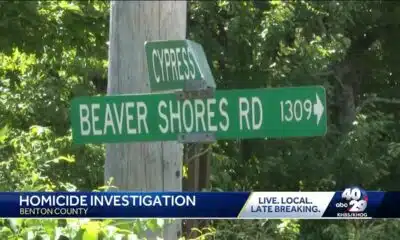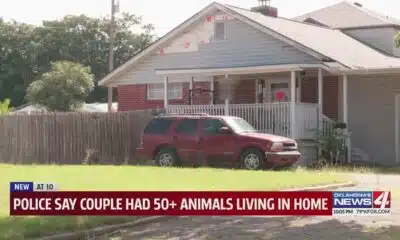Kaiser Health News
More Cities Address ‘Shade Deserts’ as Extreme Heat Triggers Health Issues
by Lauren Peace, Tampa Bay Times and Jack Prator, Tampa Bay Times
Mon, 28 Aug 2023 09:00:00 +0000
TAMPA, Fla. — If it weren’t for the traffic along South MacDill Avenue, Javonne Mansfield swears you could hear the sizzle of a frying pan.
The sun is scorching with such violent intensity that even weathered Floridians can’t help but take note.
In a hard hat, Mansfield pushes a shovel into the earth. Heat radiates from the road, the concrete parking lots. It’s around 10:30 a.m., and his crew is starting a 10-hour shift fixing traffic lights in West Tampa. Cloud coverage is minimal — thin and wispy. There’s no greenery or trees to shield them, no refuge from the blistering sun.
“I can feel it,” Mansfield says, “like I’m cooking.”
A mile south, near Palma Ceia Golf and Country Club in South Tampa, Kiki Mercier walks a poodle mix along a row of stately homes. It’s the same city on the same July day, but here, the heat feels different.
Plush lawns spotted with children’s toys help absorb the sun’s rays. But it’s the dozens of live oak trees with sprawling branches that make the biggest difference to Mercier, who walks dogs for a living.
Here, it feels possible to be outside, protected by natural tunnels of shade.
As the climate warms, a person’s health and quality of life hinge, in part, on the block where they live or work. Green space and shade can be the difference between a child playing outside and being stuck inside on hot summer days, the difference between an elderly person fainting while waiting for a bus and boarding safely, the difference between a construction worker suffering heatstroke on the job and going home to their family.
Neighborhoods with more trees and green space stay cooler, while those coated with layers of asphalt swelter. Lower-income neighborhoods tend to be hottest, a city report found, and they have the least tree canopy.
The same is true in cities across the country, where poor and minority neighborhoods disproportionately suffer the consequences of rising temperatures. Research shows the temperatures in a single city, from Portland, Oregon, to Baltimore, can vary by up to 20 degrees. For a resident in a leafy suburb, a steamy summer day may feel uncomfortable. But for their friend a few neighborhoods over, it’s more than uncomfortable — it’s dangerous.
Last month was Tampa Bay’s hottest ever. As Americans brace for an increasing number of hot days and extreme weather events linked to climate change, medical professionals stress that rising heat will make health inequities worse.
“Heat affects quality of life,” said Cheryl Holder, co-founder and interim director of Florida Clinicians for Climate Action, a coalition of medical professionals that advocates for solutions to climate change. “It’s poor and vulnerable patients who are suffering.”
Now, cities like Tampa are trying to build heat resiliency into their infrastructure — including by boosting their tree canopy — all while experts warn of a public health threat growing more severe each year.
Unrelenting Heat
As a human body warms, sweat gathers and evaporates from the skin, transferring heat away and into the air.
But in Florida, humidity hangs like a blanket, making it harder for the body’s cooling system to work.
“The sweat just doesn’t evaporate, so you don’t lose heat as effectively,” said Patrick Mularoni, a sports medicine physician at Johns Hopkins All Children’s Hospital in St. Petersburg.
In these unrelenting summer months, doctors like Mularoni have seen up close the toll heat can take.
Muscle cramps and headaches. Fatigue. Heatstroke — which can be fatal.
Daily temperatures are one benchmark of heat’s impact, but factors like humidity, wind speed, and sun angle also affect the toll on the body.
The heat index, often called the “feels like” temperature, accounts for temperature plus the added burden of humidity. For instance, while the thermometer may read 91 degrees, the heat index means it can feel like 110 degrees. The National Weather Service defines any heat index of 105 degrees or higher as dangerous.
Between 1971 and 2000, Tampa saw about four days a year with a heat index greater than 105 degrees.
By 2036, that number is projected to jump to as many as 80 days a year.
Without extreme steps to reduce global temperatures, scientists predict, Tampa residents will experience 127 “dangerous” days annually by 2099 — more than a third of the calendar year.
When the body temperature goes up to 104 as a result of overheating, the body begins dysregulating and shutting down. Decreased blood flow to the organs can cause multisystem organ failure.
Without prompt intervention to lower the body temperature, according to the Centers for Disease Control and Prevention, heatstroke can be fatal.
This summer, heat waves have killed at least 13 people in Texas and one in Louisiana, where the heat index reached 115 degrees. In Arizona, at least 18 people have died, and 69 other deaths were being investigated for potential links to heat illness. Other Arizonans have been hospitalized for serious burn injuries after touching scalding concrete.
As far north as Maryland, a 52-year-old man died in July — the state’s first recorded heat-related death of the year.
And in Parkland, Florida, a 28-year-old farm worker died of heat exposure in January after he’d spent hours pulling weeds and propping up bell pepper plants. Investigators said his death was preventable. He’d recently moved from Mexico; it was his first day on the job.
In Tampa, a Shrinking Canopy
Last year was Tampa’s hottest to date.
The city’s average annual temperature has risen by 2.5 degrees since record-keeping began in 1891, according to the city’s Climate Action and Equity Plan.
All the while, a natural tool for reducing heat has been slowly disappearing. According to a 2021 study, tree canopy coverage in Tampa is at its lowest in 26 years.
Experts say vanishing tree cover coupled with hotter summers is a lethal combination.
The uneven distribution of trees — and therefore shade — means lower-income and Hispanic neighborhoods are more affected by heat, Tampa’s city report found.
MacFarlane Park, east of Tampa International Airport, ranks among the least shady areas of the city, according to the report. It has 21% canopy coverage, or nearly a third less than the city average.
Only 15% of East Ybor City and 18% of North Hyde Park benefit from tree cover. All these neighborhoods have gradually lost trees over the past few decades.
Many factors influence the shrinking canopy, the city’s analysis found, including the loss of old and dying trees and the removal of trees for construction. In some lower-income neighborhoods, residents have chosen to cut trees down because they can’t afford the upkeep, or because dangling branches pose a threat.
Some wealthier areas are seeing faster and more recent canopy loss as old trees die or are cut down, but their total tree cover is still double that of poorer neighborhoods.
On the upper end, the canopy of mansion-lined Bayshore Boulevard is not far behind those of a series of housing developments along Flatwoods Park in New Tampa, one of which hovers around 73% coverage.
Gray Gables, a neighborhood bordering West Kennedy Boulevard, lost the highest proportion of trees from 2016 to 2021, but canopy still covers 38% of its total area.
It’s not just shade the city is losing. Trees release water vapor, which helps cool people off. Each year, according to the city’s 2021 canopy study, Tampa’s trees remove 1,000 tons of air pollutants, capture the potential carbon dioxide emissions of 847 tanker trucks’ worth of gasoline, and reduce stormwater runoff equal to 850 Olympic swimming pools.
Natural shade also determines the paths people walk — or whether they walk at all — and how often their kids can play in the yard.
On a July day in West Tampa, a girl on a bike squints as she pedals, beads of sweat dripping from her brow. A woman pushing a stroller contorts her body while waiting for the bus, trying to make use of a strip of shade no wider than 6 inches, cast from a traffic pole.
Angela Morris stands in her sun-drenched driveway and rinses sandy beach toys with a hose. She’s layered in sunscreen, but in the blazing heat, her skin is already burning.
“It’s almost unbearable,” Morris says. Her kids — ages 2 and 5 — are inside.
Do they ever play outside in the summer?
“Never,” Morris says. “It’s a lot of younger families with kids who would benefit from some shade and a sidewalk.”
Data Deficiency Poses Problems
Heat-related deaths also prove difficult to track.
A doctor might code a fatal heart attack on an extremely hot day as a cardiovascular event without noting, for example, that heat likely exacerbated the condition.
“What often gets lost are the circumstances surrounding deaths and illness,” said Christopher Uejio, a Florida State University researcher who studies the effects of climate on health and has led data projects for cities around the country.
Extreme heat in the U.S. kills more people than hurricanes, floods, and tornadoes put together, according to the National Weather Service. It’s the country’s No. 1 weather-related cause of death.
About 67,500 emergency room visits and just over 9,000 hospitalizations across the U.S. each year are tied to heat, according to the CDC.
But those numbers account only for instances in which doctors specifically code the visit as a heat-related event.
Similarly, between 2004 and 2018, an average of only 702 heat-related deaths across the country were reported to the CDC.
“We know that’s a pretty gross underestimate,” said Uejio. “Our best scientific estimates are anywhere between 5,000 to 12,000 deaths in the United States due to conditions exacerbated by heat each year.”
Low reporting continues today, experts say.
Despite patchy reporting, it appears heat-related deaths are on the rise. Last year’s number of estimated deaths was more than double the number from a decade ago.
Medical schools must teach doctors to look for and document heat-related illness, said Holder, of Florida Clinicians for Climate Action. Her group has held lectures for students and doctors on topics like the effects of climate change on patients.
Holder said she has seen how heat exposure over time harms the predominantly low-income and minority patients she served in her community clinic in South Florida.
There was the elderly man who had signs of worsening kidney function on days when he worked long shifts selling fruit on hot Miami streets.
The mother whose asthma worsened as temperatures rose.
The Fort Lauderdale woman with chronic lung disease who was arrested for fighting with her daughter over a fan. She died three days after returning to her broiling apartment.
A More Resilient City
That the tree canopy is shrinking is no surprise to city officials. In April, Tampa Mayor Jane Castor set a goal of planting 30,000 trees by 2030.
Whit Remer, Tampa’s sustainability and resilience officer, said the target might be difficult to nail.
Remer said trees are competing for space in the right of way with sidewalks and utilities. Limited open land also poses a challenge. Tampa has no room for new parks, he said. Now, it’s about maximizing that finite green space.
“Planting trees has been the hardest thing that I have done as the city’s resilience officer,” Remer said.
Remer said he’s looking to other cities for solutions. In Phoenix, a “cool pavement” pilot program uses a water-based asphalt layer to reflect heat off roads. Last year, Miami-Dade County appointed the world’s first chief heat officer. Washington and Oregon have begun distributing thousands of air conditioning units to vulnerable residents and barred utility companies from cutting power to homes during heat waves.
Remer said Tampa is still in its “learning and listening” phase. Last year, the city was awarded $300,000 by the National Academies of Sciences, Engineering, and Medicine to develop a guide for understanding and fighting the effects of heat in East Tampa, a predominantly Black neighborhood, where at least a third of children live below the poverty line.
The project director is Taryn Sabia, an urban designer and associate dean at the University of South Florida who focuses on climate resiliency work, which spans hurricane preparedness, flooding, and, increasingly, extreme heat.
Planting trees is helpful, Sabia said, but they take time to grow and effort to maintain. Quicker actions could include erecting better shade structures at bus stops or implementing rules for construction to encourage the use of materials that generate less heat in the sun. For example, some cities in the Northeast — including Philadelphia and New York — provide financial incentives for “green roofs,” in which the top of a building is covered with plants.
Another easy step: painting everything white. Light colors reflect sunlight, while dark colors absorb heat.
And while Florida codes require homes to have a mechanism to provide heat in the winter, there are no codes requiring landlords to provide air conditioning.
“You can no longer be here and not have it,” Sabia said.
Tampa could better tailor weather advisories for specific needs and neighborhoods, she said. Heat becomes more dangerous more quickly on upper floors of older apartments, for example, because heat rises. Expanding access to cooling shelters is also key.
It’s the hottest week of the year so far in Tampa, and 75-year-old Benjamin Brown is walking home from the eye doctor, about a 30-minute walk.
There are few trees in sight, but Brown, who is without a car, makes a similar trek every day, running errands, visiting friends.
“It’s very oppressive. It does get to me,” Brown says as he nods, wipes his forehead, and continues down the street in the blistering Tampa sun.
Shade — any shade — would be a lifesaver, he said.
This article was produced in partnership with the Tampa Bay Times.
By: Lauren Peace, Tampa Bay Times and Jack Prator, Tampa Bay Times
Title: More Cities Address ‘Shade Deserts’ as Extreme Heat Triggers Health Issues
Sourced From: kffhealthnews.org/news/article/cities-shade-deserts-extreme-heat-heatstroke-tampa/
Published Date: Mon, 28 Aug 2023 09:00:00 +0000
Did you miss our previous article…
https://www.biloxinewsevents.com/untangling-ron-desantis-debate-anecdote-about-an-improbable-abortion-survival-story/
Kaiser Health News
States Brace for Reversal of Obamacare Coverage Gains Under Trump’s Budget Bill
Shorter enrollment periods. More paperwork. Higher premiums. The sweeping tax and spending bill pushed by President Donald Trump includes provisions that would not only reshape people’s experience with the Affordable Care Act but, according to some policy analysts, also sharply undermine the gains in health insurance coverage associated with it.
The moves affect consumers and have particular resonance for the 19 states (plus Washington, D.C.) that run their own ACA exchanges.
Many of those states fear that the additional red tape — especially requirements that would end automatic reenrollment — would have an outsize impact on their policyholders. That’s because a greater percentage of people in those states use those rollovers versus shopping around each year, which is more commonly done by people in states that use the federal healthcare.gov marketplace.
“The federal marketplace always had a message of, ‘Come back in and shop,’ while the state-based markets, on average, have a message of, ‘Hey, here’s what you’re going to have next year, here’s what it will cost; if you like it, you don’t have to do anything,’” said Ellen Montz, who oversaw the federal ACA marketplace under the Biden administration as deputy administrator and director at the Center for Consumer Information and Insurance Oversight. She is now a managing director with the Manatt Health consulting group.
Millions — perhaps up to half of enrollees in some states — may lose or drop coverage as a result of that and other changes in the legislation combined with a new rule from the Trump administration and the likely expiration at year’s end of enhanced premium subsidies put in place during the covid-19 pandemic. Without an extension of those subsidies, which have been an important driver of Obamacare enrollment in recent years, premiums are expected to rise 75% on average next year. That’s starting to happen already, based on some early state rate requests for next year, which are hitting double digits.
“We estimate a minimum 30% enrollment loss, and, in the worst-case scenario, a 50% loss,” said Devon Trolley, executive director of Pennie, the ACA marketplace in Pennsylvania, which had 496,661 enrollees this year, a record.
Drops of that magnitude nationally, coupled with the expected loss of Medicaid coverage for millions more people under the legislation Trump calls the “One Big Beautiful Bill,” could undo inroads made in the nation’s uninsured rate, which dropped by about half from the time most of the ACA’s provisions went into effect in 2014, when it hovered around 14% to 15% of the population, to just over 8%, according to the most recent data.
Premiums would rise along with the uninsured rate, because older or sicker policyholders are more likely to try to jump enrollment hurdles, while those who rarely use coverage — and are thus less expensive — would not.
After a dramatic all-night session, House Republicans passed the bill, meeting the president’s July 4 deadline. Trump is expected to sign the measure on Independence Day. It would increase the federal deficit by trillions of dollars and cut spending on a variety of programs, including Medicaid and nutrition assistance, to partly offset the cost of extending tax cuts put in place during the first Trump administration.
The administration and its supporters say the GOP-backed changes to the ACA are needed to combat fraud. Democrats and ACA supporters see this effort as the latest in a long history of Republican efforts to weaken or repeal Obamacare. Among other things, the legislation would end several changes put in place by the Biden administration that were credited with making it easier to sign up, such as lengthening the annual open enrollment period and launching a special program for very low-income people that essentially allows them to sign up year-round.
In addition, automatic reenrollment, used by more than 10 million people for 2025 ACA coverage, would end in the 2028 sign-up season. Instead, consumers would have to update their information, starting in August each year, before the close of open enrollment, which would end Dec. 15, a month earlier than currently.
That’s a key change to combat rising enrollment fraud, said Brian Blase, president of the conservative Paragon Health Institute, because it gets at what he calls the Biden era’s “lax verification requirements.”
He blames automatic reenrollment, coupled with the availability of zero-premium plans for people with lower incomes that qualify them for large subsidies, for a sharp uptick in complaints from insurers, consumers, and brokers about fraudulent enrollments in 2023 and 2024. Those complaints centered on consumers’ being enrolled in an ACA plan, or switched from one to another, without authorization, often by commission-seeking brokers.
In testimony to Congress on June 25, Blase wrote that “this simple step will close a massive loophole and significantly reduce improper enrollment and spending.”
States that run their own marketplaces, however, saw few, if any, such problems, which were confined mainly to the 31 states using the federal healthcare.gov.
The state-run marketplaces credit their additional security measures and tighter control over broker access than healthcare.gov for the relative lack of problems.
“If you look at California and the other states that have expanded their Medicaid programs, you don’t see that kind of fraud problem,” said Jessica Altman, executive director of Covered California, the state’s Obamacare marketplace. “I don’t have a single case of a consumer calling Covered California saying, ‘I was enrolled without consent.’”
Such rollovers are common with other forms of health insurance, such as job-based coverage.
“By requiring everyone to come back in and provide additional information, and the fact that they can’t get a tax credit until they take this step, it is essentially making marketplace coverage the most difficult coverage to enroll in,” said Trolley at Pennie, 65% of whose policyholders were automatically reenrolled this year, according to KFF data. KFF is a health information nonprofit that includes KFF Health News.
Federal data shows about 22% of federal sign-ups in 2024 were automatic-reenrollments, versus 58% in state-based plans. Besides Pennsylvania, the states that saw such sign-ups for more than 60% of enrollees include California, New York, Georgia, New Jersey, and Virginia, according to KFF.
States do check income and other eligibility information for all enrollees — including those being automatically renewed, those signing up for the first time, and those enrolling outside the normal open enrollment period because they’ve experienced a loss of coverage or other life event or meet the rules for the low-income enrollment period.
“We have access to many data sources on the back end that we ping, to make sure nothing has changed. Most people sail through and are able to stay covered without taking any proactive step,” Altman said.
If flagged for mismatched data, applicants are asked for additional information. Under current law, “we have 90 days for them to have a tax credit while they submit paperwork,” Altman said.
That would change under the tax and spending plan before Congress, ending presumptive eligibility while a person submits the information.
A white paper written for Capital Policy Analytics, a Washington-based consultancy that specializes in economic analysis, concluded there appears to be little upside to the changes.
While “tighter verification can curb improper enrollments,” the additional paperwork, along with the expiration of higher premiums from the enhanced tax subsidies, “would push four to six million eligible people out of Marketplace plans, trading limited fraud savings for a surge in uninsurance,” wrote free market economists Ike Brannon and Anthony LoSasso.
“Insurers would be left with a smaller, sicker risk pool and heightened pricing uncertainty, making further premium increases and selective market exits [by insurers] likely,” they wrote.
KFF Health News is a national newsroom that produces in-depth journalism about health issues and is one of the core operating programs at KFF—an independent source of health policy research, polling, and journalism. Learn more about KFF.
USE OUR CONTENT
This story can be republished for free (details).
KFF Health News is a national newsroom that produces in-depth journalism about health issues and is one of the core operating programs at KFF—an independent source of health policy research, polling, and journalism. Learn more about KFF.
Subscribe to KFF Health News’ free Morning Briefing.
This article first appeared on KFF Health News and is republished here under a Creative Commons license.
The post States Brace for Reversal of Obamacare Coverage Gains Under Trump’s Budget Bill appeared first on kffhealthnews.org
Note: The following A.I. based commentary is not part of the original article, reproduced above, but is offered in the hopes that it will promote greater media literacy and critical thinking, by making any potential bias more visible to the reader –Staff Editor.
Political Bias Rating: Center-Left
This content presents a critique of Republican-led changes to the Affordable Care Act, emphasizing potential negative impacts such as increased premiums, reduced enrollment, and the erosion of coverage gains made under the ACA. It highlights the perspective of policy analysts and state officials who express concern over these measures, while also presenting conservative viewpoints, particularly those focusing on fraud reduction. Overall, the tone and framing lean toward protecting the ACA and its expansions, which traditionally aligns with Center-Left media analysis.
Kaiser Health News
Dual Threats From Trump and GOP Imperil Nursing Homes and Their Foreign-Born Workers
In a top-rated nursing home in Alexandria, Virginia, the Rev. Donald Goodness is cared for by nurses and aides from various parts of Africa. One of them, Jackline Conteh, a naturalized citizen and nurse assistant from Sierra Leone, bathes and helps dress him most days and vigilantly intercepts any meal headed his way that contains gluten, as Goodness has celiac disease.
“We are full of people who come from other countries,” Goodness, 92, said about Goodwin House Alexandria’s staff. Without them, the retired Episcopal priest said, “I would be, and my building would be, desolate.”
The long-term health care industry is facing a double whammy from President Donald Trump’s crackdown on immigrants and the GOP’s proposals to reduce Medicaid spending. The industry is highly dependent on foreign workers: More than 800,000 immigrants and naturalized citizens comprise 28% of direct care employees at home care agencies, nursing homes, assisted living facilities, and other long-term care companies.
But in January, the Trump administration rescinded former President Joe Biden’s 2021 policy that protected health care facilities from Immigration and Customs Enforcement raids. The administration’s broad immigration crackdown threatens to drastically reduce the number of current and future workers for the industry. “People may be here on a green card, and they are afraid ICE is going to show up,” said Katie Smith Sloan, president of LeadingAge, an association of nonprofits that care for older adults.
Existing staffing shortages and quality-of-care problems would be compounded by other policies pushed by Trump and the Republican-led Congress, according to nursing home officials, resident advocates, and academic experts. Federal spending cuts under negotiation may strip nursing homes of some of their largest revenue sources by limiting ways states leverage Medicaid money and making it harder for new nursing home residents to retroactively qualify for Medicaid. Care for 6 in 10 residents is paid for by Medicaid, the state-federal health program for poor or disabled Americans.
“We are facing the collision of two policies here that could further erode staffing in nursing homes and present health outcome challenges,” said Eric Roberts, an associate professor of internal medicine at the University of Pennsylvania.
The industry hasn’t recovered from covid-19, which killed more than 200,000 long-term care facility residents and workers and led to massive staff attrition and turnover. Nursing homes have struggled to replace licensed nurses, who can find better-paying jobs at hospitals and doctors’ offices, as well as nursing assistants, who can earn more working at big-box stores or fast-food joints. Quality issues that preceded the pandemic have expanded: The percentage of nursing homes that federal health inspectors cited for putting residents in jeopardy of immediate harm or death has risen alarmingly from 17% in 2015 to 28% in 2024.
In addition to seeking to reduce Medicaid spending, congressional Republicans have proposed shelving the biggest nursing home reform in decades: a Biden-era rule mandating minimum staffing levels that would require most of the nation’s nearly 15,000 nursing homes to hire more workers.
The long-term care industry expects demand for direct care workers to burgeon with an influx of aging baby boomers needing professional care. The Census Bureau has projected the number of people 65 and older would grow from 63 million this year to 82 million in 2050.
In an email, Vianca Rodriguez Feliciano, a spokesperson for the Department of Health and Human Services, said the agency “is committed to supporting a strong, stable long-term care workforce” and “continues to work with states and providers to ensure quality care for older adults and individuals with disabilities.” In a separate email, Tricia McLaughlin, a Department of Homeland Security spokesperson, said foreigners wanting to work as caregivers “need to do that by coming here the legal way” but did not address the effect on the long-term care workforce of deportations of classes of authorized immigrants.
Goodwin Living, a faith-based nonprofit, runs three retirement communities in northern Virginia for people who live independently, need a little assistance each day, have memory issues, or require the availability of around-the-clock nurses. It also operates a retirement community in Washington, D.C. Medicare rates Goodwin House Alexandria as one of the best-staffed nursing homes in the country. Forty percent of the organization’s 1,450 employees are foreign-born and are either seeking citizenship or are already naturalized, according to Lindsay Hutter, a Goodwin spokesperson.
“As an employer, we see they stay on with us, they have longer tenure, they are more committed to the organization,” said Rob Liebreich, Goodwin’s president and CEO.
Jackline Conteh spent much of her youth shuttling between Sierra Leone, Liberia, and Ghana to avoid wars and tribal conflicts. Her mother was killed by a stray bullet in her home country of Liberia, Conteh said. “She was sitting outside,” Conteh, 56, recalled in an interview.
Conteh was working as a nurse in a hospital in Sierra Leone in 2009 when she learned of a lottery for visas to come to the United States. She won, though she couldn’t afford to bring her husband and two children along at the time. After she got a nursing assistant certification, Goodwin hired her in 2012.
Conteh said taking care of elders is embedded in the culture of African families. When she was 9, she helped feed and dress her grandmother, a job that rotated among her and her sisters. She washed her father when he was dying of prostate cancer. Her husband joined her in the United States in 2017; she cares for him because he has heart failure.
“Nearly every one of us from Africa, we know how to care for older adults,” she said.
Her daughter is now in the United States, while her son is still in Africa. Conteh said she sends money to him, her mother-in-law, and one of her sisters.
In the nursing home where Goodness and 89 other residents live, Conteh helps with daily tasks like dressing and eating, checks residents’ skin for signs of swelling or sores, and tries to help them avoid falling or getting disoriented. Of 102 employees in the building, broken up into eight residential wings called “small houses” and a wing for memory care, at least 72 were born abroad, Hutter said.
Donald Goodness grew up in Rochester, New York, and spent 25 years as rector of The Church of the Ascension in New York City, retiring in 1997. He and his late wife moved to Alexandria to be closer to their daughter, and in 2011 they moved into independent living at the Goodwin House. In 2023 he moved into one of the skilled nursing small houses, where Conteh started caring for him.
“I have a bad leg and I can’t stand on it very much, or I’d fall over,” he said. “She’s in there at 7:30 in the morning, and she helps me bathe.” Goodness said Conteh is exacting about cleanliness and will tell the housekeepers if his room is not kept properly.
Conteh said Goodness was withdrawn when he first arrived. “He don’t want to come out, he want to eat in his room,” she said. “He don’t want to be with the other people in the dining room, so I start making friends with him.”
She showed him a photo of Sierra Leone on her phone and told him of the weather there. He told her about his work at the church and how his wife did laundry for the choir. The breakthrough, she said, came one day when he agreed to lunch with her in the dining room. Long out of his shell, Goodness now sits on the community’s resident council and enjoys distributing the mail to other residents on his floor.
“The people that work in my building become so important to us,” Goodness said.
While Trump’s 2024 election campaign focused on foreigners here without authorization, his administration has broadened to target those legally here, including refugees who fled countries beset by wars or natural disasters. This month, the Department of Homeland Security revoked the work permits for migrants and refugees from Cuba, Haiti, Nicaragua, and Venezuela who arrived under a Biden-era program.
“I’ve just spent my morning firing good, honest people because the federal government told us that we had to,” Rachel Blumberg, president of the Toby & Leon Cooperman Sinai Residences of Boca Raton, a Florida retirement community, said in a video posted on LinkedIn. “I am so sick of people saying that we are deporting people because they are criminals. Let me tell you, they are not all criminals.”
At Goodwin House, Conteh is fearful for her fellow immigrants. Foreign workers at Goodwin rarely talk about their backgrounds. “They’re scared,” she said. “Nobody trusts anybody.” Her neighbors in her apartment complex fled the U.S. in December and returned to Sierra Leone after Trump won the election, leaving their children with relatives.
“If all these people leave the United States, they go back to Africa or to their various countries, what will become of our residents?” Conteh asked. “What will become of our old people that we’re taking care of?”
KFF Health News is a national newsroom that produces in-depth journalism about health issues and is one of the core operating programs at KFF—an independent source of health policy research, polling, and journalism. Learn more about KFF.
Subscribe to KFF Health News’ free Morning Briefing.
This article first appeared on KFF Health News and is republished here under a Creative Commons license.
The post Dual Threats From Trump and GOP Imperil Nursing Homes and Their Foreign-Born Workers appeared first on kffhealthnews.org
Note: The following A.I. based commentary is not part of the original article, reproduced above, but is offered in the hopes that it will promote greater media literacy and critical thinking, by making any potential bias more visible to the reader –Staff Editor.
Political Bias Rating: Center-Left
This content primarily highlights concerns about the impact of restrictive immigration policies and Medicaid spending cuts proposed by the Trump administration and Republican lawmakers on the long-term care industry. It emphasizes the importance of immigrant workers in healthcare, the challenges that staffing shortages pose to patient care, and the potential negative effects of GOP policy proposals. The tone is critical of these policies while sympathetic toward immigrant workers and advocates for maintaining or increasing government support for healthcare funding. The framing aligns with a center-left perspective, focusing on social welfare, immigrant rights, and concern about the consequences of conservative economic and immigration policies without descending into partisan rhetoric.
Kaiser Health News
California’s Much-Touted IVF Law May Be Delayed Until 2026, Leaving Many in the Lurch
California lawmakers are poised to delay the state’s much-ballyhooed new law mandating in vitro fertilization insurance coverage for millions, set to take effect July 1. Gov. Gavin Newsom has asked lawmakers to push the implementation date to January 2026, leaving patients, insurers, and employers in limbo.
The law, SB 729, requires state-regulated health plans offered by large employers to cover infertility diagnosis and treatment, including IVF. Nine million people will qualify for coverage under the law. Advocates have praised the law as “a major win for Californians,” especially in making same-sex couples and aspiring single parents eligible, though cost concerns limited the mandate’s breadth.
People who had been planning fertility care based on the original timeline are now “left in a holding pattern facing more uncertainty, financial strain, and emotional distress,” Alise Powell, a director at Resolve: The National Infertility Association, said in a statement.
During IVF, a patient’s eggs are retrieved, combined with sperm in a lab, and then transferred to a person’s uterus. A single cycle can total around $25,000, out of reach for many. The California law requires insurers to cover up to three egg retrievals and an unlimited number of embryo transfers.
Not everyone’s coverage would be affected by the delay. Even if the law took effect July 1, it wouldn’t require IVF coverage to start until the month an employer’s contract renews with its insurer. Rachel Arrezola, a spokesperson for the California Department of Managed Health Care, said most of the employers subject to the law renew their contracts in January, so their employees would not be affected by a delay.
She declined to provide data on the percentage of eligible contracts that renew in July or later, which would mean those enrollees wouldn’t get IVF coverage until at least a full year from now, in July 2026 or later.
The proposed new implementation date comes amid heightened national attention on fertility coverage. California is now one of 15 states with an IVF mandate, and in February, President Donald Trump signed an executive order seeking policy recommendations to expand IVF access.
It’s the second time Newsom has asked lawmakers to delay the law. When the Democratic governor signed the bill in September, he asked the legislature to consider delaying implementation by six months. The reason, Newsom said then, was to allow time to reconcile differences between the bill and a broader effort by state regulators to include IVF and other fertility services as an essential health benefit, which would require the marketplace and other individual and small-group plans to provide the coverage.
Newsom spokesperson Elana Ross said the state needs more time to provide guidance to insurers on specific services not addressed in the law to ensure adequate and uniform coverage. Arrezola said embryo storage and donor eggs and sperm were examples of services requiring more guidance.
State Sen. Caroline Menjivar, a Democrat who authored the original IVF mandate, acknowledged a delay could frustrate people yearning to expand their families, but requested patience “a little longer so we can roll this out right.”
Sean Tipton, a lobbyist for the American Society for Reproductive Medicine, contended that the few remaining questions on the mandate did not warrant a long delay.
Lawmakers appear poised to advance the delay to a vote by both houses of the legislature, likely before the end of June. If a delay is approved and signed by the governor, the law would immediately be paused. If this does not happen before July 1, Arrezola said, the Department of Managed Health Care would enforce the mandate as it exists. All plans were required to submit compliance filings to the agency by March. Arrezola was unable to explain what would happen to IVF patients whose coverage had already begun if the delay passes after July 1.
The California Association of Health Plans, which opposed the mandate, declined to comment on where implementation efforts stand, although the group agrees that insurers need more guidance, spokesperson Mary Ellen Grant said.
Kaiser Permanente, the state’s largest insurer, has already sent employers information they can provide to their employees about the new benefit, company spokesperson Kathleen Chambers said. She added that eligible members whose plans renew on or after July 1 would have IVF coverage if implementation of the law is not delayed.
Employers and some fertility care providers appear to be grappling over the uncertainty of the law’s start date. Amy Donovan, a lawyer at insurance brokerage and consulting firm Keenan & Associates, said the firm has fielded many questions from employers about the possibility of delay. Reproductive Science Center and Shady Grove Fertility, major clinics serving different areas of California, posted on their websites that the IVF mandate had been delayed until January 2026, which is not yet the case. They did not respond to requests for comment.
Some infertility patients confused over whether and when they will be covered have run out of patience. Ana Rios and her wife, who live in the Central Valley, had been trying to have a baby for six years, dipping into savings for each failed treatment. Although she was “freaking thrilled” to learn about the new law last fall, Rios could not get clarity from her employer or health plan on whether she was eligible for the coverage and when it would go into effect, she said. The couple decided to go to Mexico to pursue cheaper treatment options.
“You think you finally have a helping hand,” Rios said of learning about the law and then, later, the requested delay. “You reach out, and they take it back.”
This article was produced by KFF Health News, which publishes California Healthline, an editorially independent service of the California Health Care Foundation.
KFF Health News is a national newsroom that produces in-depth journalism about health issues and is one of the core operating programs at KFF—an independent source of health policy research, polling, and journalism. Learn more about KFF.
USE OUR CONTENT
This story can be republished for free (details).
KFF Health News is a national newsroom that produces in-depth journalism about health issues and is one of the core operating programs at KFF—an independent source of health policy research, polling, and journalism. Learn more about KFF.
Subscribe to KFF Health News’ free Morning Briefing.
This article first appeared on KFF Health News and is republished here under a Creative Commons license.
The post California’s Much-Touted IVF Law May Be Delayed Until 2026, Leaving Many in the Lurch appeared first on kffhealthnews.org
Note: The following A.I. based commentary is not part of the original article, reproduced above, but is offered in the hopes that it will promote greater media literacy and critical thinking, by making any potential bias more visible to the reader –Staff Editor.
Political Bias Rating: Center-Left
This content is presented in a factual, balanced manner typical of center-left public policy reporting. It focuses on a progressive healthcare issue (mandated IVF insurance coverage) favorably highlighting benefits for diverse family structures and individuals, including same-sex couples and single parents, which often aligns with center-left values. At the same time, it includes perspectives from government officials, industry representatives, opponents, and patients, offering a nuanced view without overt ideological framing or partisan rhetoric. The emphasis on healthcare access, social equity, and patient impact situates the coverage within a center-left orientation.
-
News from the South - Tennessee News Feed5 days ago
Bread sold at Walmart, Kroger stores in TN, KY recalled over undeclared tree nut
-
News from the South - Georgia News Feed1 day ago
Aiken County family fleeing to Mexico due to Trump immigration policies
-
News from the South - Arkansas News Feed7 days ago
Man shot and killed in Benton County, near Rogers
-
News from the South - Alabama News Feed6 days ago
Girls Hold Lemonade Stand for St. Jude Hospital | July 12, 2025 | News 19 at 10 p.m. – Weekend
-
News from the South - Georgia News Feed7 days ago
Anti-ICE demonstrators march to Beaufort County Sheriff's Office
-
News from the South - Oklahoma News Feed7 days ago
Police say couple had 50+ animals living in home
-
Mississippi Today4 days ago
Coast judge upholds secrecy in politically charged case. Media appeals ruling.
-
Local News5 days ago
Oyster spawning begins as MDMR-USM Hatchery Program enters production phase using mobile hatchery















































